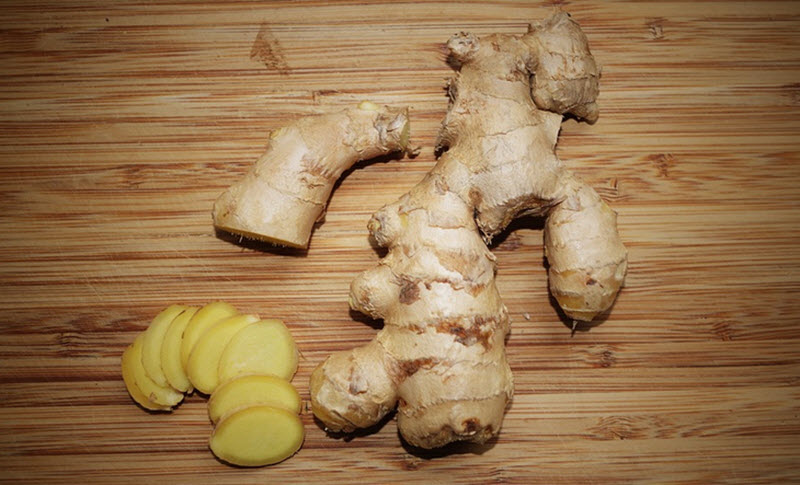Contents

Ginger (Zingiber officinale) is a perennial flowering plant that grows to be about one meter tall and produce yellow flowers. It is a member of the family Zingiberaceae, where we also find turmeric (Curcuma longa) and cardamom (Elettaria cardamomum). Ginger, turmeric and cardamom are all celebrated not just for their taste but also for their health promoting properties.
Ginger originated in the tropical rain forest of Southern Asia, probably in India since that is where we find the largest genetic diversity of ginger. It is an important ingredient in local medical traditions within its native range. During the first century AD, export of ginger to Europe commenced, as a part of the blossoming spice trade.
| Scientific classification | |
| Kingdom: | Plantae |
| Clade: | Angiosperms |
| Clade: | Monocots |
| Clade: | Commelinids |
| Order: | Zingiberales |
| Family: | Zingiberaceae |
| Genus: | Zingiber |
| Species: | Zingiber officinale |
| Binomial name | |
| Zingiber officinale | |
Ginger root
It is the underground rhizome of the ginger that is most commonly used in food, drinks and traditional medicine. In some recipes you will see it called ginger root instead of just ginger.
The rhizome looks like a fat root, but is actually a modified subterranean stem used to store starches, proteins and other nutrients. The rhizome has the ability to send out roots and shoots from its nodes.

Buying ginger
In stores, ginger rhizome is sold in various forms.
- Whole fresh rhizomes provide the freshest taste, but do not store as well as dried rhizomes.
- Ginger powder is usually made from either dried rhizome or fresh young rhizomes that has been peeled, sliced and cooked in heavy sugar syrup.
- Crystallized ginger is sold as a snack. Rhizomes are cooked in sugar syrup, air dried and rolled in sugar.
- Pickled ginger is traditionally made from thinly sliced rhizomes. It is especially popular in Japan, where it is known as gari.
Ginger and health
The fragrance and flavor of ginger is largely due to essential oil, primarily zingerone, shogaols and gingerols. The major pungent compound in the ginger rhizome is [6]-gingerol, a compound fairly closely related to capsaicin (found in chilli pepper) and piperine (found in black pepper).
When ginger is dried or heated, the [6]-gingerol is transformed into zingerone and [6]-shogaol. Zingerone is responsible for the sweetness of dried or cooked ginger. Shogaols are roughly twice as spicy as gingerol, which is why dried ginger is more pungent than fresh.
Gingerol
- [6]-gingerol is toxic for certain types of cancer cells and is being researched as a possible treatment for lung cancer and leukemia.
- For rheumatoid arthritis, [6]-gingerol have yielded some noteworthy results in animal testing.
- The process of gingering horses prior to horse shows depends on the potency of gingerol as a chemical irritant. This practice has been banned from most hose shows, and in some countries it is also a criminal offense.
Zingerone
- Zingerone is active against enterotoxin-induced diarrhea caused by the bacterium Escherichia coli.
- Zingerone inhibit obesity-induced inflammation. This is probably linked to its ability to stimulate the release of catecholamines that aids in the breakdown of fat cells.
Shogaol
- Shogaol has a strong antitussive (anti-cough) effect.
- Shogaol can help reduce blood pressure.
- A study published in 2004 indicated that shogaol reduces the effect of neuroinflammation and cognitive deficits in animal models of dementia. (Source: Moon M, et al. 6-Shogaol, an active constituent of ginger, attenuates neuroinflammation and cognitive deficits in animal models of dementia. Biochemical and Biophysical Research Communications. June 2014; 449(1):8-13.)
Ginger an nausea
Ginger is widely used as an alternative treatment for nausea, including morning sickness during pregnancy, sea sickness and sickness caused by chemotherapy. In limited studies, it has been found to be more effective than placebo, but more research is needed. It has not been found to be more effective than placebo against postoperative nausea.
The sialagogue action of ginger
Ginger has a sialagogue action, which means that it stimulates the excretion of saliva. Because of this, ginger in the food can make it easier to swallow the food.
Ginger and kidney / gall stones
Ginger contains moderate amounts of oxalate. If you have a history of developing kidney stones or gall stones that contain oxalate, keep your ginger consumption low.
Ginger can interact with certain medical drugs
Ginger interact with certain medications, including the anticoagulant drug warfarin and the cardiovascular drug nifedipine.
